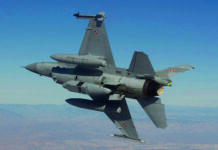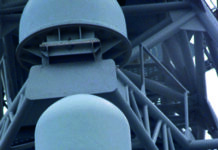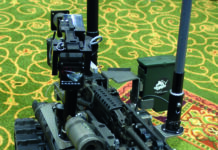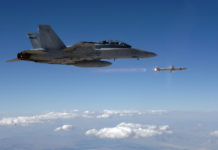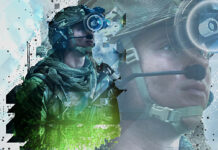For the front-line soldier, the most common night-vision (NV) system is the night-vision goggle (NVG). Following the Desert Storm campaign in 1991, NV systems were credited with having been essential for the coalition’s success against Iraq.
They gave soldiers the ability to fight at night, and were particularly effective when engaging an enemy who lacked such combat aids. But that night-combat superiority has been eroded over the last quarter of a century. When US-led coalitions began operations in Afghanistan and later Iraq, they faced an enemy that had been able to acquire small numbers of older NV systems. In subsequent years, ISIL combatants and other US enemies have been able to obtain growing numbers of high-performance NV systems, eroding the tactical advantage that Western forces had enjoyed during night operations.
In today’s world, NVGs are being manufactured by at least 17 nations, so enemy forces down to the level of insurgents can obtain these in substantial numbers. Breaking this potential deadlock depends of fielding higher-performance sensors that can cope with poor conditions such as the presence of dust or smoke. This would allow friendly forces to purposely create extremely degraded conditions that would severely degrade an enemy’s NV capabilities.
Image Intensification

Two techniques are widely used by NV systems – image intensification (I2) and thermal imaging (TI). Image intensification systems use an objective lens to collect whatever tiny amount of light and near infrared is available at night from sources such as moonlight or starlight. This energy is focussed onto the input photocathode of an I2 tube. When the incoming photons strike the photocathode, they release electrons which can be amplified, then reconverted to create a visible display.
Early I2 tubes were classified as Generation 0 (Gen 0) and Generation I (Gen 1). Their size and weight did not allow early NV systems to be made small enough for infantry use. The 1970s saw the introduction of Generation II tubes which incorporated a new element known as a microchannel. Located ahead of the photocathode, this was a thin disk made from millions of microscopic-sized parallel glass rods stacked in a bundle. As electrons passed down the rods, some struck the walls of the tube, and these impacts released a shower of secondary electrons, which in turn generated more collisions with the wall and yet more secondary electrons. Gen 0 and Gen I tubes had a low gain, so several had to be connected in series in order to create a useable HV system, but a single Gen II tube has a gain of around 10,000, so can provide good imagery in extremely low light conditions, such as a moonless night.
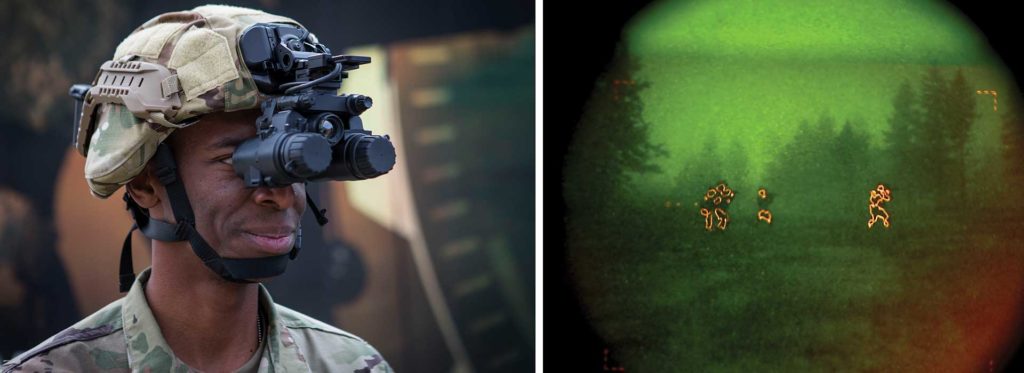
First fielded in the 1980s, Gen III tubes use a photocathode made from gallium arsenide rather the multi-alkali material used for Gen II devices. They have a high level of performance at wavelengths of between 0.6 – 0.9 microns, so are better able to exploit night-sky radiance (which increases with wavelength and peaks at around 1.1 microns) than the Gen II tubes (whose response declined from 0.5 microns and was minimal at 0.9 microns). Gen III devices also have a longer life than their Gen II counterparts, but are more expensive.

The performance of Gen III devices has been boosted by several technological developments. The use of an automatic gated power supply system regulates the photocathode voltage, giving the device the ability to rapidly adapt to changing light conditions – for example when the user is moving between high-light to low-light environments. It also helps a tube used on a weapon sight to cope with muzzle flash when the weapon is fired. The use of a much thinner ion barrier (or even no ion barrier) can minimise image noise but reduces the life of the tube by around 25 percent. While manufacturers sometimes promote these “filmless and gated” tubes as being Gen IV, the US military uses the term GEN-III OMNI-VII.
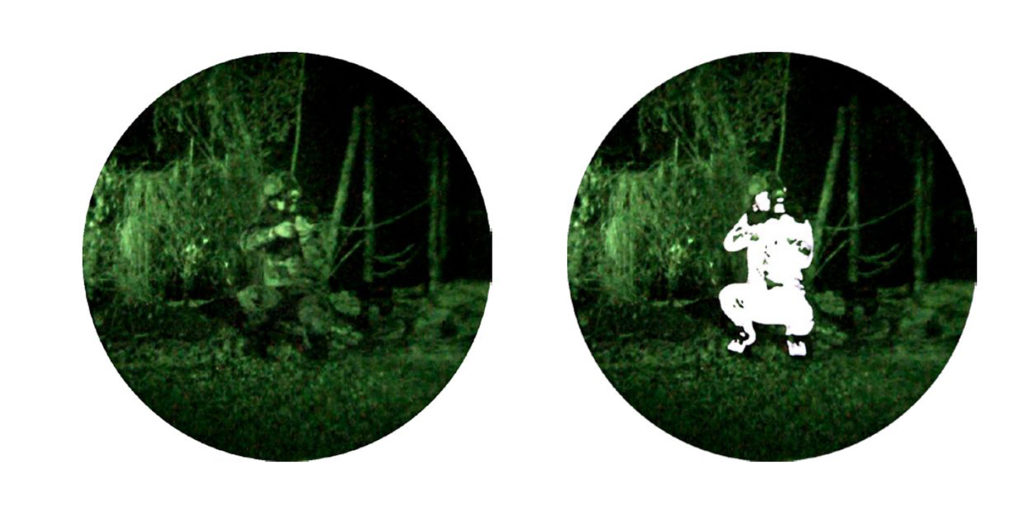
Thermal Imaging Systems
Thermal imaging systems sense the temperature difference between an object and its environment by converting infrared radiation into visible light. The earliest examples typically used moving mirrors to scan the external scene, a technique that allowed the use of relatively simple detector elements. However, the breakthrough that allowed the fielding of low-cost imaging systems was the development of two-dimensional (2D) arrays of IR sensors in which each sensor could be dedicated to each pixel in the display, eliminating the need for a scanning mechanism. The development of uncooled arrays began in the early 1980s, and led to the development of microbolometers, the thermal-imaging technology used in NVGs.
Although I2 sensors provide high resolution, TI sensors provide a longer target-detection range, and can allow the user to see through smoke. They can also provide a clearer image than is available from an I2 system if the latter is being used in a low-contrast environment.
Image Fusion
The breakthrough that the US DoD hopes will restore the edge in night time combat involves combining thermal and I2 imagery in a single device that will give soldiers the ability to exploit the best features of both techniques. One of the early systems created to exploit image fusion was the ITT (now Harris) AN/PSQ-20 Enhanced NVG (ENVG). Designed to combine the outputs of a 16-mm I2 tube and a 320 X 240 pixel microbolometer, it was intended to replace the older AN/PVS-7 and AN/PVS-14 systems. Approximately the same size as the AN/PVS-14, it used a similar control layout in order to simplify training. Fielded in 2009 as the ENVG I, the AN/PSQ-20 entered service on only a limited scale. It was much heavier than the PVS-14, and drained batteries quickly.
The AN/PSQ-20 formed the basis of the AN/PSQ-20A Spiral Enhanced Night Vision Goggle (SENVG) system that was developed under a 2010 DoD contract intended to meet the US Army’s ENVG II requirement. It used a separate battery pack that allowed helmet-mounted or hand-held use, and incorporated a colour microdisplay.
Another 2010 contract awarded to what was then Northrop Grumman EOS (now L3 Warrior Systems) under the ENVG III programme covered an alternative design designated AN/PSQ-20B. Earlier iterations of the ENVG had two modes – fused vision, or image intensification only. The ENVG III added more modes to the thermal imager to enhance target detection capabilities. It can show either the I2 or thermal imagery, or be used in one of three fusion modes – overlay (which showed the hotter parts of the thermal image), outline (with thermal imagery given a bright white outline that makes them easier to see, and full fusion (which combines the full output of the I2 and thermal channels).
A second ENVG III design was developed by BAE Systems. According to the company, it uses 12-micron TI technology to produce sharp thermal images, and was optimised for low power consumption.
Imagery from the Sight
A second technological trend is the ability to connect NVGs to the sight on the soldier’s weapon, allowing the user to aim the weapon without bringing it up to his shoulder, or point the weapon around a corner, acquiring a target without exposing himself to enemy fire. One major feature of this third iteration of the ENVG concept is that it can be wirelessly linked to the Family of Weapon Sights-Individual – a capability first tested by US Army personnel in 2017. Imagery from the sight is displayed in a 19 degree wide secondary image that is superimposed over the main image. The FWS-I can be mounted on a range of personal weapons such as the M4 carbine, M16A4 rifle, M249 Squad Automatic Weapon, M136 AT4 light antitank weapon, and the M141 Bunker Defeat Munition.
Binocular Devices
Many older NVGs are monocular, providing imagery either via a single eyepiece or from two eyepieces that share the output from a single tube. With the latter configuration, both eyes see the same image, so there is no stereoscopic effect and no depth perception. Having a two-channel binocular system in which each eye receives an independent image from its own tube provides perception of depth. However, the tubes needed for a binocular configuration are likely to be physically smaller than that needed for a single-tube biocular design, so will gather less energy than the larger tube of a good binocular NVG, and have a lower resolution.
Most current NVGs techniques produce monochrome images from green phosphor technology, but some more recent designs use white phosphors in order to display a more eye-friendly image that makes object recognition easier, and that does not create spurious colours when the user takes the device off after using it for several minutes (magenta if you look at a light area, or green if you look at a dark area).
The Request for Information (RFI) issued in January 2018 for what would become the Enhanced Night Vision Goggle – Binocular (ENVG-B) specified that the system was to incorporate dual white- phosphor I2 tubes and an integrated thermal imager. It should provide fused imagery, and under normal conditions, target recognition of an upright moving man was to be possible 80% of the time at ranges of up to 400 metres. In conditions of limited visibility (such as fog, salt fog, haze, mist, snow, dust, smoke and other battlefield obscurants), it was to be possible 90 percent of the time at ranges of up to 50 metres. An integrated full-colour microdisplay was to have a format of at least 1280×960 pixels.
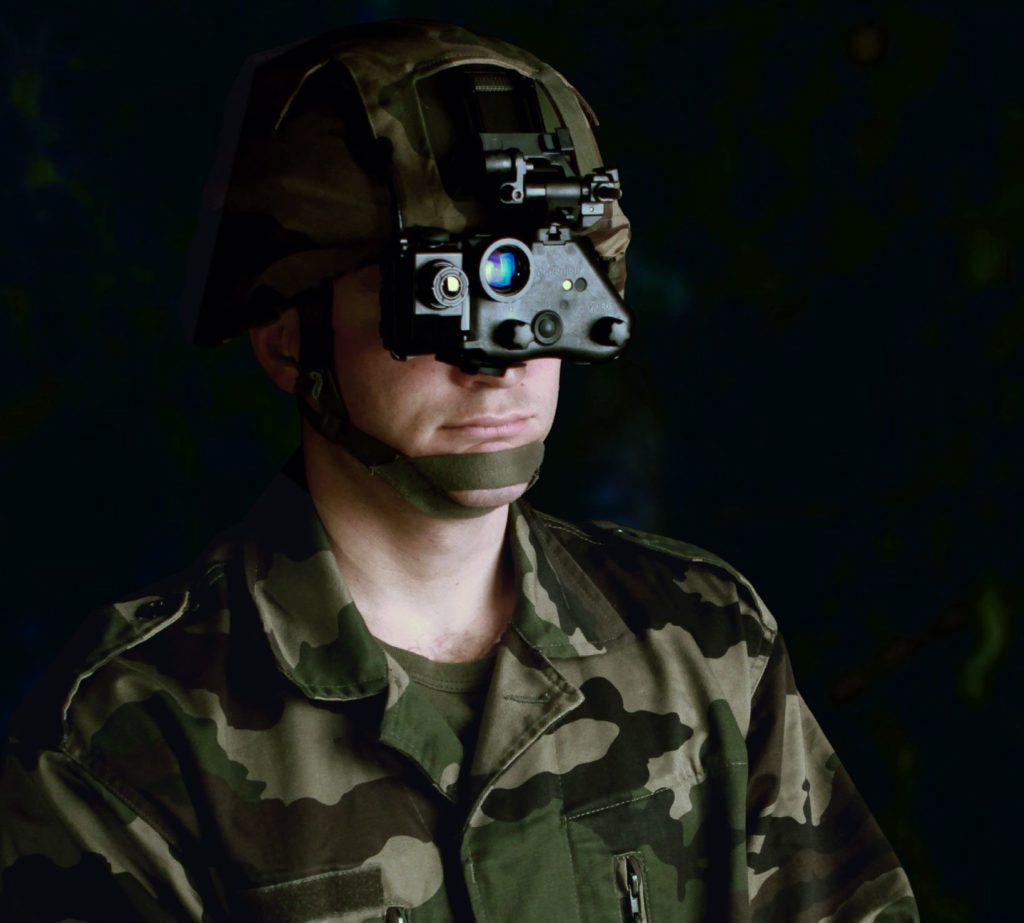
Wireless Interfaces
A multi-point wireless interface for subsystems such as the Family of Weapon Sights – Individual (FWS-I) is intended to allow the import of the weapon sensor reticle and video into the goggle, along with data from a handheld targeting sensor, navigational aid, the NETT Warrior (formerly known as the Ground Soldier System) situational awareness (SA) system.
The plan called for the delivery of up to approximately 40 prototypes for Engineering and Manufacturing Development (EMD), to be followed by approximately 90,000 full-rate production systems over a seven-year period. In 2018 the US Army awarded L3 Technologies a three-year, US$391M contract to produce the Enhanced Night Vision Goggle–Binocular (ENVG-B).
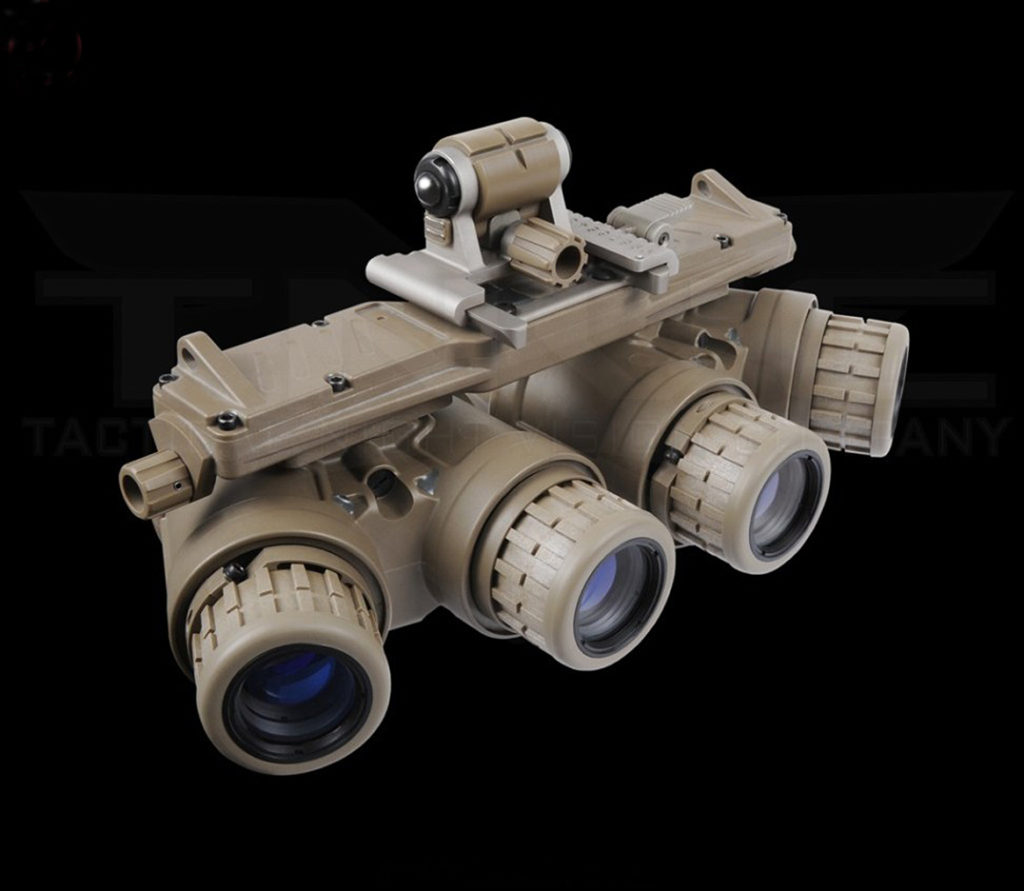
Clip-on Attachment
One alternative to procuring an NVG that provides fused imagery is to mount a clip-on thermal imager in front of the optics of an I2 sensor. An early example of this approach is the Clip-On Thermal Imager (COTI) developed by Optics 1 (now part of Safran Vectronix) for use on the AN/PVS-15 binocular NVG. Safran Vectronix’s Thermal Acquisition Clip-on System-Miniature (TACS-M) extends this concept to fit a wide range of NVGs, including the AN/PVS-7, AN/PVS-14, AN/PVS-18, and AN/PVS-23. It uses an uncooled 320 x 240 pixel MWIR microbolometer to overlay a thermal image onto the I2 output.
A similar approach as taken by Thales Angénieux (now Thales France) with its MINIE-DIR. Based on an uncooled LWIR 384×288 array, this is a clip-on attachment for the company’s MINIE-D (MIniature Night Intensified Equipment – Display). Selected to form part of France’s FELIN (Fantassin à Equipments et Liaisons INtégres) future soldier system, the MINIE-D incorporates an OLED (organic light-emitting diode) display able to handle externally-supplied information, including weapon-sight imagery.
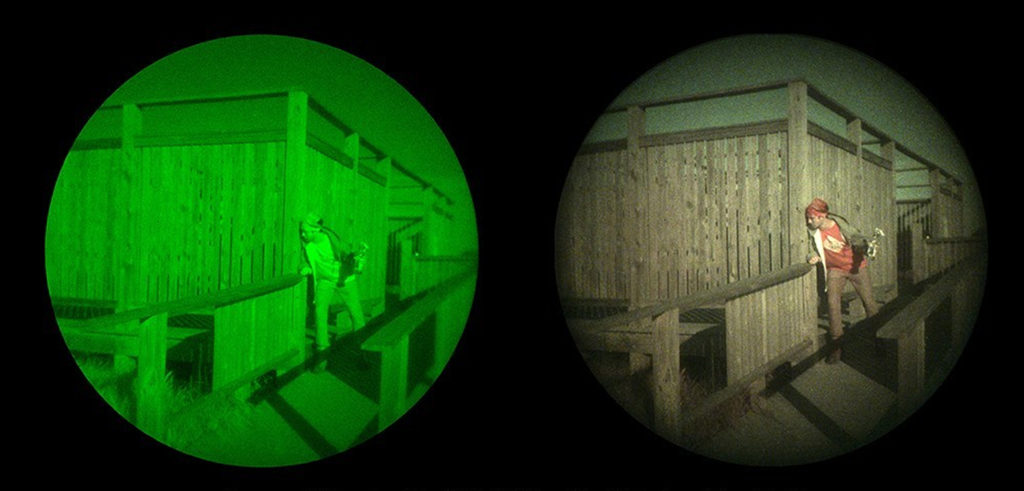
Minie D NVG has a threshold or “decamouflage” mode that brightens all human-range temperatures. This is intended to make soldiers stand out more on a cluttered thermal background. Minie D also incorporates an integrated OLED video array which allows external data such as weapon sight images or maps to be displayed. Addition of the MINIE-DIR allows the combined system to show the wearer a partial (Improved Menace Detection) or full IR image.
NVGs do not magnify the external scene, but present it at the same scale as the naked eye. However, their field of view (FOV) is much less than the naked eye, usually around 40 degrees. Gather up a dozen leaflets on NVG systems at the next defence exhibition that you attend, and you will find that in almost all cases, the FOV specified is 40 degrees.
Wide-angle Systems
This narrow FOV deprives the NVG user with the peripheral vision needed to provide situational awareness. As a result, the wearer must perform aggressive head scanning in order to maintain minimal situational awareness, and this can result in neck strain. The restricted FOV also makes navigation and orientation difficult, particularly in unfamiliar terrain. Not surprisingly, these limitations have spurred work on wide-angle systems that extend the angular coverage well beyond 40 degrees.
An early example was the Clara NVG from what was then SFIM. This had a 50 degree FOV. More recent instances are the Meopta MonoKlara (with a 50 degree FOV), and the Thales France MONIE (MOnocular Intensified Equipment) and OIP Sensor Systems FELIS NVGs (both with a 51 degree FOV).
One method of providing a wider FOV is to base the NVG on a horizontal array of four tubes. This extends to FOV to just over 90 degrees. In the 1990s the US Air Force adopted four-tube NVGs for use on aircraft such as the A-10 Thunderbolt II, MC-130 Combat Talon and AC-130U Spooky, but the concept soon became operational with various special forces. Four-tube NVGs currently being marketed include the Ground Panoramic Night-Vision Goggle (GPNVG) from L3 Warrior Systems. This uses multiple 18mm I2 tubes to provide a 97 x 40 degree FOV.
One potential problem with horizontal arrays of tubes is the regions of the image in which the FOVs of two individual tubes must merge. When the cinema industry used a horizontal array of three projectors to display imagery originally captured by an array of three cameras, this Cinerama pioneering wide-screen process suffered from problems in the areas where the images overlapped. So it was hardly surprising that Cinerama was soon replaced by wide-screen systems that used a single camera.
History seems likely to repeat itself. One potential problem with four-tube NVGs is that the imagery from two overlapping fields of view may not overlap perfectly, while the image height at the overlap is restricted. A wide-FOV unit based on a single tube would avoid these limitations. In 2016 Kent Optronics was given a contract by the US Navy to develop the Wide Field-Of-View Foveal-Night Vision Goggle (WFOV F-NVG). This is a two-tube binocular that uses a wide angle foveal eyepiece and foveal objective lens to deliver an 80 degree FOV from each of the Gen III image intensifier tubes.
Colour Vision
It is hardly surprising that some NGV users would like to see the introduction of systems offering colour vision. This could help soldiers tell the difference between friendly forces, enemy personnel or civilians, or in peacekeeping operations could help sentries tell whether the colour of an approaching vehicle matched that of one on a ‘be-on-lookout’ list.
Some early experiments showed promise; in 1995 MIT Lincoln Laboratory reported that imagery from the visible through near IR band from a Gen III image intensifier tube combined with thermal IR imagery from an uncooled thermal imaging array showed what was described as “remarkably realistic colour renderings of night scenes”.
Several of the earliest systems for creating colour cine films were based on rotating colour filters mounted ahead of the lens of the cine camera used to capture the scene, and the lens of the projector used to display the finished film, so perhaps in it not surprising that the US company Chromatra has adopted a similar solution in order to create an NVG that creates a colour image. Intended for use with an existing I2 device such as the AN/PVS-14, its CVA-14 Colour Enhancer is a clip-on system that positions rotating filters in front the lens and between the eyepiece of the user’s eye. Although the colour rendering is degraded by the limited spectral coverage of current I2 technology, the system produces useable imagery.
Another approach to colour night vision is demonstrated by the Adams Industries’ SENTINEL-CNV NVGs. Designed for use by the US Special Forces, and deployed since 2003, these use I2 tubes which the company says “utilise proprietary modifications to deliver meaningful and repeatable colour contrast at low light levels associated with night-time operations. The goggles are optimised to present more lifelike colour under moderate illumination conditions, and better contrast under all conditions.”
Outlook
Inevitably, new capabilities such as image fusion and colour vision will become more widely available that at present, so the combat edge that they offer will decline. So once again, new NV technologies will be needed. If today’s state-of-the-art NVGs fuse imagery from two frequency bands, next-generation NV technologies could involve three or even more bands. This will inevitably raise potential problems in terms of bulk, weight. and power consumption, but could maintain the West’s superiority in night combat.
Following an earlier career in engineering, Doug Richardson is a defence journalist specialising in topics such as aircraft, missiles, and military electronics.





